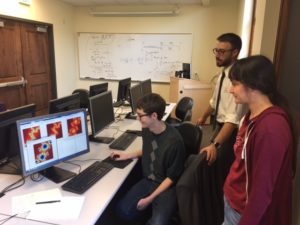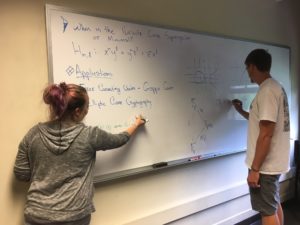 Summer may seem like a relatively quiet time for CSU’s campus, but not for a handful of very busy mathematics undergraduates. These 16 students are participating in CSU’s first-ever summer math research program, led by Professor of Mathematics Rachel Pries and Associate Professor of Mathematics Patrick Shipman.
Summer may seem like a relatively quiet time for CSU’s campus, but not for a handful of very busy mathematics undergraduates. These 16 students are participating in CSU’s first-ever summer math research program, led by Professor of Mathematics Rachel Pries and Associate Professor of Mathematics Patrick Shipman.
Shipman is mentoring two groups of students: one studying fractal patterns produced by dynamics of hyperbolic numbers and the other working in The Laboratory for Mathematics in the Sciences alongside Professor of Chemistry Stephen Thompson to examine micro weather patterns and anthocyanins, a pigment found in fruits and plants. Pries’ group is studying the properties of Hurwitz curves over finite fields, a topic with applications to cryptography. The program is funded in part by the College of Natural Sciences and the Department of Mathematics, in addition to a National Science Foundation grant.
“They’re all amazing students,” said Shipman. “And I think they’re very excited to be doing something a little different than coursework.”
A change of pace
The program is part of a departmental initiative to get more mathematics undergraduates involved in original research. “There are specific research goals there, but another goal is [for students] to get a feel for what mathematical research is,” said Shipman. “To see that there is math beyond just working on problems at the back of the book that someone tells you to do. The freedom to explore and decide their path.”
Shipman hopes programs like this one will help dispel common misconceptions surrounding careers in mathematics. “I think a lot of high school students think that if they want to do mathematics they should go into engineering or something that uses math,” he said. “But there’s a lot of new math research going on.”
Teamwork makes the dreamwork
 Many long days spent pouring over research papers and working on complex equations has taught the students in the cartography group to lean on one another’s strengths. “It’s kind of like working on a car,” said Dean Bisogno, a graduate student helping to mentor the group. “If everyone was working on the same part, no one would get anything done. But everyone excels in different areas.”
Many long days spent pouring over research papers and working on complex equations has taught the students in the cartography group to lean on one another’s strengths. “It’s kind of like working on a car,” said Dean Bisogno, a graduate student helping to mentor the group. “If everyone was working on the same part, no one would get anything done. But everyone excels in different areas.”
The uniqueness of the experience is likely to stick with the students long after the six-week course is over. “I feel really lucky that this happened while I was here,” said Amethyst Price, a fourth-year mathematics undergrad. “It’s also really nice to meet people that I have classes with and make those connections too. I think it’s a really awesome opportunity.”